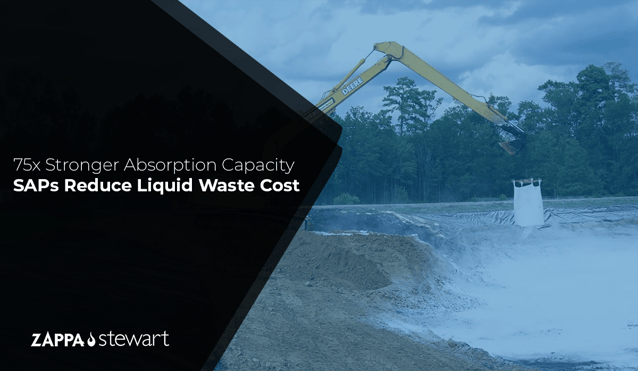
Solidification of liquid wastes is a widely used waste management method in a variety of industrial sectors. When evaluating different solidification products, absorption capacity is a critical parameter that should be understood before making a selection. Superabsorbent polymers (SAP) feature an absorption capacity that is approximately 75 times greater than traditional absorbents such as sawdust and dried granular corn cobs.
Because liquid wastes, such as wastewater sludge, drilling muds, and dredged sediments are logistically challenging to transport and rarely accepted for disposal at landfills, transforming the waste into a solid often proves to be economical and convenient.
What is Absorption Capacity?
Absorption capacity is the measure of the amount of water absorbed by a specific amount of material. As such, it is a direct indicator of the efficiency of an absorbent waste treatment technology.
When managing a liquid waste operation, maximizing the absorption capacity of a solidification media empowers engineers and contractors to MINIMIZE the following:
- The amount of media that is shipped to the site (Less shipping costs and time spent off-loading)
- The amount of media that is staged on-site (less space occupied on the project site)
- The amount of media that must be blended into the waste material (Less time, fuel, and manpower spent processing waste)
- The amount of media that must be loaded onto dump trucks (Less manpower spent loading)
- The amount of media that must be hauled to the disposal facility (Fewer trucks, less fuel)
- The amount of media that is dumped at the landfill (lower tipping fees at landfill)
Higher absorption capacity directly correlates to time savings, space savings, and treatment & disposal costs.
Related Article: Improving the Compressive Strength of CCR
Comparing Absorption Capacity Between Common Liquid Waste Solidifiers
Not only do SAPs offer a higher absorption capacity than traditional absorbents, but the absorption capacity of SAP is two orders of magnitude greater!
Traditional industrial absorbents like sawdust, granular corn cobs, and wood pellets have absorption capacities of ~4 times their own weight. Superabsorbent polymers (SAPs) feature absorption capacities that often exceed 300 times their own weight, the highest absorption capacity of any commercially available material.
SAP vs Traditional Solidifiers
To highlight the impact SAP use can have on a liquid waste solidification project, consider the following example: 10,000 tons of PCB-impacted sediments are to be excavated from a lagoon at a chemical plant, solidified, and disposed as solid waste. Sawdust, corn cobs, and SAPs are evaluated as the solidification media options.
Based on their absorption capacity, the amount of each media required would be:
- 1,250 tons of sawdust
- 1,250 tons of corn cobs
- 17 tons of SAP
SAP is selected due to the much smaller quantity required and the subsequent savings in time and treatment and disposal costs. Cost savings for landfill tipping fees alone, using SAP, would be approximately $100,000.
Related Article: Fast Liquid Waste Solidification with Superabsorbent Polymers
In conclusion, when evaluating strategies for managing liquid waste, it is wise to understand the absorption capacity of the potential solidification products. It is a parameter that makes a big difference in project costs and time on-site.
To learn more about SAP properties and how SAP can help you meet your liquid waste management goals, please sign up to receive our blogs. You can also contact us for a custom site evaluation.






